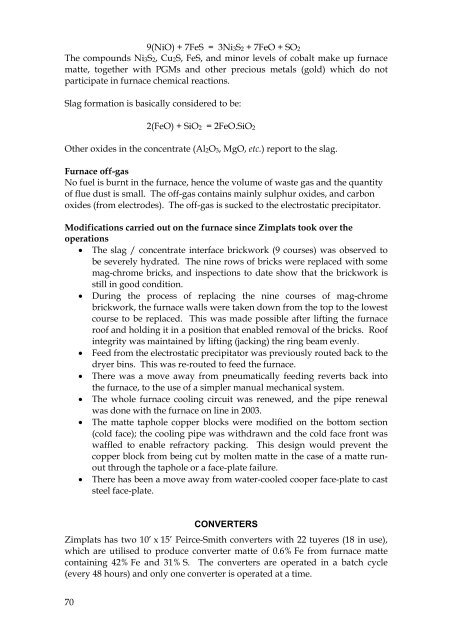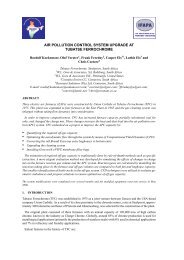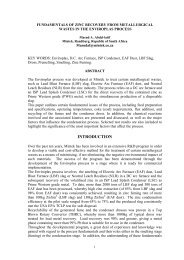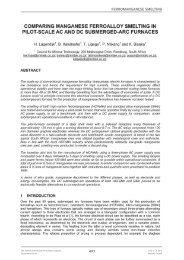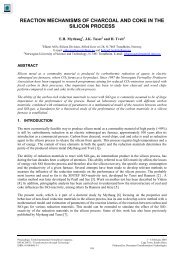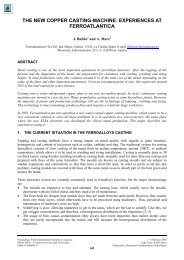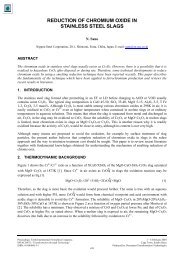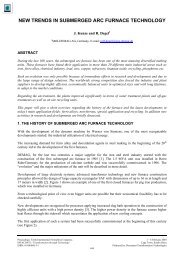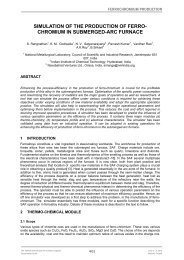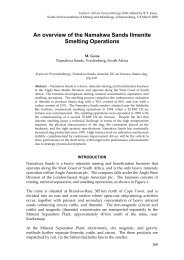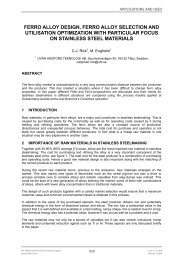An overview of PGM Smelting in Zimbabwe – Zimplats ... - saimm
An overview of PGM Smelting in Zimbabwe – Zimplats ... - saimm
An overview of PGM Smelting in Zimbabwe – Zimplats ... - saimm
Create successful ePaper yourself
Turn your PDF publications into a flip-book with our unique Google optimized e-Paper software.
9(NiO) + 7FeS = 3Ni3S2 + 7FeO + SO2The compounds Ni3S2, Cu2S, FeS, and m<strong>in</strong>or levels <strong>of</strong> cobalt make up furnacematte, together with <strong>PGM</strong>s and other precious metals (gold) which do notparticipate <strong>in</strong> furnace chemical reactions.Slag formation is basically considered to be:2(FeO) + SiO2 = 2FeO.SiO2Other oxides <strong>in</strong> the concentrate (Al2O3, MgO, etc.) report to the slag.Furnace <strong>of</strong>f-gasNo fuel is burnt <strong>in</strong> the furnace, hence the volume <strong>of</strong> waste gas and the quantity<strong>of</strong> flue dust is small. The <strong>of</strong>f-gas conta<strong>in</strong>s ma<strong>in</strong>ly sulphur oxides, and carbonoxides (from electrodes). The <strong>of</strong>f-gas is sucked to the electrostatic precipitator.Modifications carried out on the furnace s<strong>in</strong>ce <strong>Zimplats</strong> took over theoperations• The slag / concentrate <strong>in</strong>terface brickwork (9 courses) was observed tobe severely hydrated. The n<strong>in</strong>e rows <strong>of</strong> bricks were replaced with somemag-chrome bricks, and <strong>in</strong>spections to date show that the brickwork isstill <strong>in</strong> good condition.• Dur<strong>in</strong>g the process <strong>of</strong> replac<strong>in</strong>g the n<strong>in</strong>e courses <strong>of</strong> mag-chromebrickwork, the furnace walls were taken down from the top to the lowestcourse to be replaced. This was made possible after lift<strong>in</strong>g the furnacero<strong>of</strong> and hold<strong>in</strong>g it <strong>in</strong> a position that enabled removal <strong>of</strong> the bricks. Ro<strong>of</strong><strong>in</strong>tegrity was ma<strong>in</strong>ta<strong>in</strong>ed by lift<strong>in</strong>g (jack<strong>in</strong>g) the r<strong>in</strong>g beam evenly.• Feed from the electrostatic precipitator was previously routed back to thedryer b<strong>in</strong>s. This was re-routed to feed the furnace.• There was a move away from pneumatically feed<strong>in</strong>g reverts back <strong>in</strong>tothe furnace, to the use <strong>of</strong> a simpler manual mechanical system.• The whole furnace cool<strong>in</strong>g circuit was renewed, and the pipe renewalwas done with the furnace on l<strong>in</strong>e <strong>in</strong> 2003.• The matte taphole copper blocks were modified on the bottom section(cold face); the cool<strong>in</strong>g pipe was withdrawn and the cold face front waswaffled to enable refractory pack<strong>in</strong>g. This design would prevent thecopper block from be<strong>in</strong>g cut by molten matte <strong>in</strong> the case <strong>of</strong> a matte runoutthrough the taphole or a face-plate failure.• There has been a move away from water-cooled cooper face-plate to caststeel face-plate.CONVERTERS<strong>Zimplats</strong> has two 10’ x 15’ Peirce-Smith converters with 22 tuyeres (18 <strong>in</strong> use),which are utilised to produce converter matte <strong>of</strong> 0.6% Fe from furnace matteconta<strong>in</strong><strong>in</strong>g 42% Fe and 31% S. The converters are operated <strong>in</strong> a batch cycle(every 48 hours) and only one converter is operated at a time.70


